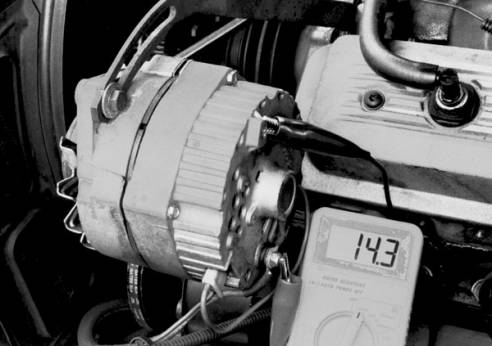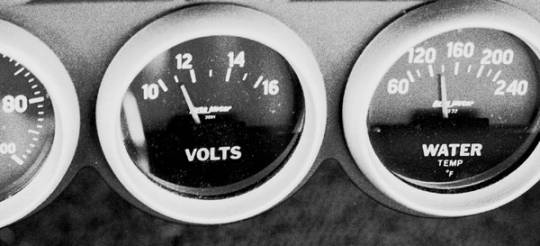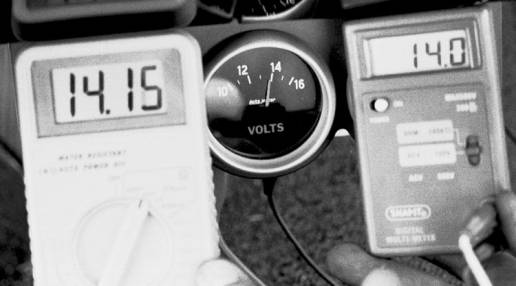|
Many
thanks from
M.A.D. to CHEVY HIGH PERFORMANCE magazine’s Jeff
Smith, for loaning us his really nice
’65 El Camino for this project.
BRIGHTER
HEAD LIGHTS
Getting
out of the DARK AGES!
It
takes more than a powerful alternator, and more than
changing to powerful replacement headlights, to get
brighter headlights on these older cars and trucks.

The
above photo was taken with High Beams ON, and the engine
was running at highway cruise RPM.
14.1 volts measured at the Horn Relay was perfect.
(It’s the main power distribution buss-bar in
this electrical system.) But the headlights were only running at 11.5 volts!
The
voltage drop to the headlights in the above measurements
was typical, as the headlight system on many cars is
under-wired
The
headlights on our older cars and trucks are not very
bright. They weren't when these cars were new. But when those cars were new, we didn't have anything better
to compare our lights to.
So the dim headlights were accepted as normal.
Nowadays, many people replace the old headlight
sealed beams with more modern HALOGEN replacements.
It's true that the halogen's do not look yellow at
low voltage, like the old sealed beams did.
But the HALOGEN replacements also do not
produce maximum illumination when operating at low voltage.
Thinking
of popping in killer European H-4 headlights?
Unless the "real problem"
is fixed, those powerful replacements will only compound
the built-in deficiency.
That's true because they will draw more current,
resulting with even greater voltage drop in the
"under-wired" factory system.
Furthermore,
Our American made cars and trucks have had automatic-reset
circuit breakers built into the headlight switch for many
years. And the circuit breaker is not rated for the greater current
draw of those powerful H-4's.
Many
owners of Ford cars and trucks, built in the '60's and
'70's, especially with the four headlight systems, are
familiar with the headlights flashing OFF and ON.
(Like erratic Morse Code, after driving awhile on
High Beams.) The
problem occurred because the circuit breaker in the
headlight switch was weak.
Simply installing H-4's in most of our older cars
and trucks will result with the same effect known to old
Fords. (The
circuit breakers in original factory headlight switches
cannot handle the extra current draw of the more powerful
headlights.)
HOW
BAD IS THE EXISTING PERFORMANCE?
Lighting
systems engineering data has it that if we drop the
voltage delivered to a light by 10%, then illumination
out-put is reduced by over 30%.
Going from 14.0 volts down to 11.5 volts is a loss
of nearly 18%! As
we shall see in photos–No wonder those old cars and
trucks have dim lights (when factory equipped).
The goal with electrical systems is to keep voltage
drops within a 2% loss.
If
you're wondering how much the up-grade would help your
favorite car or truck, it's really quite simple to do as
we did and take measurements with a VOLTMETER.
(The photo captions explain the voltage
measurements recorded by these photos.)
If
voltage measured at the back of the headlight, with High
Beams ON, and engine running at highway cruise RPM, is
less than 13.5 volts–Then this headlight/relay up-grade
will be an improvement.
Most factory built cars and trucks will not perform
better than 12.0v - 12.8v range, and many will drop below
12.0v, even with perfect factory wiring.
TIP:
The
meter wires must be connected to the head light terminals
with the car's wire harness connected to the headlight.
Even with "two headlight" systems, the
High Beams are higher in wattage (they draw more current),
and so the system should be tested with High Beams
ON.
In
photos and captions, here are the before and after the
test voltage measurements at key parts of the electrical
system.

High
Beams ON, Engine running at highway cruise RPM.
(Photo taken indoors, evening, the hood was
blocking overhead shop lights–so the powerful camera
flash "strobe" froze the alternator fan as if it
was still.) The
Alternator system is working perfectly–that's definitely
not the problem.
This
car was previously up-graded to a GM DELCO, 63amp, model
10SI, built-in voltage regulator system.
It is properly wired using M.A.D.'s part # ALT-1,
Alternator Wiring Kit. The kit's new 8 gauge wire is
routed from the alternator directly to the horn relay
buss-bar.

High
Beams ON, plus heater fan ON medium speed, plus windshield
wipers ON, Engine running at highway cruise RPM–barely
over 11 volts at the dash!
WE
HAVE A PROBLEM HERE!
The
more switches we turn ON, the lower the voltmeter shows.
The dash-mounted voltmeter gives us the indication
that the alternator is not able to keep up with system
demands.
 But,
we went back to the alternator, and to the battery, and to
the horn relay buss-bar, (the "key
check-points") and rechecked voltage levels.
With the engine running at highway cruise RPM,
lights, heater, and wipers ON, we had 14.1 to 14.3 volts
at all the "key check-points" under the hood.
(Which is perfect.) But,
we went back to the alternator, and to the battery, and to
the horn relay buss-bar, (the "key
check-points") and rechecked voltage levels.
With the engine running at highway cruise RPM,
lights, heater, and wipers ON, we had 14.1 to 14.3 volts
at all the "key check-points" under the hood.
(Which is perfect.)

Sometimes
in attempt to learn, "Just who is telling the truth
here?"–It's a good idea to get second and third
opinions. Ha!
It turns out that all three voltmeters gave us
pretty close to the same story.
We
got out another digital voltmeter, and connected two
digital voltmeters to the stud terminals at the back of
our dash mounted voltmeter, and ran the engine
at highway cruise RPM, no
lights or accessories ON.
The
digital meter on the left is actually the most accurate of
these three. It
was by far the most expensive.
A reputable company, which calibrates and certifies
diagnostic equipment, has checked it. And its readings are always consistent with other
"high-end," expensive meters.
Also, when switched to 20v, it measures to the
nearest 1/100th of a volt.
And,
after this photo was taken, we did switch the lights ON,
and the heater to medium, and found that all three
voltmeters dropped back down to less than 12 volts.
But yet, under the hood still showing 14 volts.
Well
now, what we have going on here is "voltage
drop," in the factory wiring, to the dash area. The wiring in the car was inspected, and found to be in
perfect condition–the problem is with design, not
with defective parts or wiring!

 We
even looked at the factory wiring diagrams, and found that
the "battery live" buss-bar behind the fuse box
was directly connected to the dash area "main feed
wire." We
even looked at the factory wiring diagrams, and found that
the "battery live" buss-bar behind the fuse box
was directly connected to the dash area "main feed
wire."
So,
we could read voltage at the dash area main feed wire,
from the fuse box, and we did.
High Beams ON, heater fan on medium, engine running at highway
cruise RPM. We
measured only 11.22 here, (still with over 14 volts under
the hood). Yep! We
definitely have voltage drop in the dash main power-up
circuit. And the same wire powers-up the headlight switch!

The
term "buss-bar" means a "common"
connection, where wires all connected to the same circuit
can come and go.
"Junction
block" is another term often used to describe this
function.
On
our project car, the alternator output wire is routed
directly to this buss-bar.
The dash area main power-up wire originates at this
buss-bar.
The battery charging wire is connected at this
buss-bar.
And, the voltage regulator takes "sensing
voltage" reading here, and adjusts alternator output
to maintain voltage level at this buss-bar (14.0v to
14.5v).

click
here to continue
See the performance after RELAYS have been
installed.
|